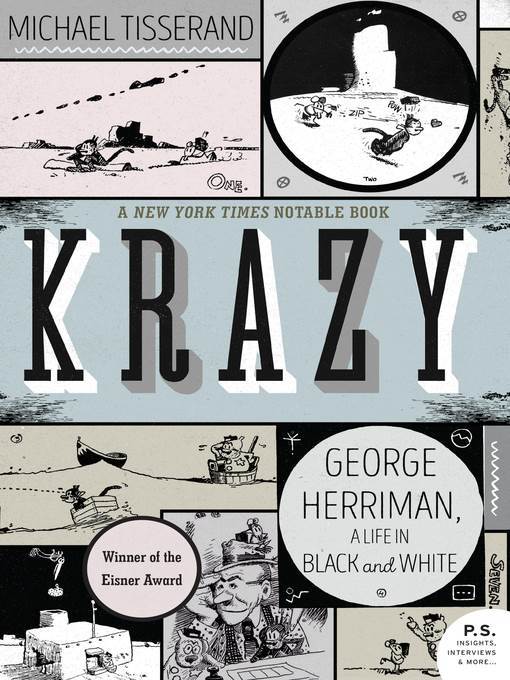
Krazy
George Herriman, a Life in Black and White
کتاب های مرتبط
- اطلاعات
- نقد و بررسی
- دیدگاه کاربران
نقد و بررسی

October 17, 2016
Tisserand (The Kingdom of Zydeco) weaves American history, pop culture, and racial politics with biography to elucidate and celebrate the life of cartoonist George Herriman (1880–1944), the creator of the Krazy Kat comic strip. Readers gain a glut of insight into the development of Krazy Kat, and the many ways the character served as an outlet for Herriman to playfully explore the human condition, which Tisserand sets against the backdrop of Herriman’s own little-known racial identity. Though Herriman passed as a white man his whole life, he was actually African-American, born during Reconstruction to a Creole family that hid its racial identity by moving from New Orleans to California when Herriman was 10. Tisserand reconstructs Herriman’s multicultural background and follows him from his childhood through his apprenticeship in Los Angeles, his big break in New York City, and frequent trips to the Southwest, using these places in their variety to animate Herriman’s identity and provide nuance to his growth as a comics artist. This is a gripping read at the intersection of pop culture and American history.

Starred review from October 1, 2016
A revelatory biography of the influential Krazy Kat creator George Herriman (1880-1944).Set among the desert mesas of Coconino County, Krazy Kat graced the funny pages from 1913 to 1944 and featured the philosophical antics of Krazy and the brick-throwing mouse, Ignatz. Tisserand (Sugarcane Academy: How a New Orleans Teacher and His Storm-Struck Students Created a School to Remember, 2007, etc.) reveals the depths of their age-old rivalry, tracing influences from Cervantes and Othello to minstrel shows and the Jack Johnson vs. Jim Jeffries bout of 1910. Krazy Kat always had a racial angle: Herriman was born a fair-skinned boy to African-American parents and grew up in the Creole community of New Orleans. His complexion allowed him to pass as white, a controversial practice that Herriman carried secretly throughout his life. Though he penned numerous stripse.g., "Us Husbands," "Baron Mooch," and "The Family Upstairs"it wasnt until the publication of Krazy Katin 1913 that he moved toward the life of a celebrated artist, garnering praise from the likes of e.e. cummings and President Woodrow Wilson. Herrimans unique racial perspective allowed him to sneak some remarkably potent themes into his cartoons, many of which were likely lost on his readers at the time: Krazy, for instance, is revealed to have been born in the cellar of a haunted house, in a tale which must never be told, and yet which everyone knows. In another gag, Ignatz flings a mug at Krazy saying its not the black coffee he wanted. Sure it is, Krazy tells him. Look unda the milk. Tisserand elevates this exhaustively researched and profusely illustrated book beyond the typical comics biography. Seamlessly integrating the story of Herrimans life, he executes an impressive history of early-20th-century race relations, the rise of Hearst and the newspaper boom, and the burgeoning cross-continental society life of New York and Los Angeles. Essential reading for comics fans and history buffs, Krazy is a roaring success, providing an indispensable new perspective on turn-of-the-century America.
COPYRIGHT(2016) Kirkus Reviews, ALL RIGHTS RESERVED.

November 15, 2016
Tisserand (The Kingdom of Zydeco) presents a well-researched, engaging biography of George Herriman (1880-1944), creator of the comic strip Krazy Kat. This brilliant but modestly successful strip ran in American newspapers from 1913 to 1944 and influenced luminaries such as Bill Watterson and Charles Schulz. The chronicle begins with the lives of Herriman's great grandparents in New Orleans before detailing Herriman's early years and the family's migration to the Los Angeles area. From there, the author foregrounds Herriman's budding career as a comics writer as he bounced among prominent newspapers and boxing matches, eventually landing in the offices of newspaper publisher William Randolph Hearst, who would later become a great champion of Krazy Kat. Tisserand also weaves in the challenges Herriman faced trying to hide his African American lineage--colleagues often teased him because of his "kinky hair" and for a time dubbed him "George the Greek" because he would not discuss his background. At every step, this work brilliantly re-creates the milieu of its subject's life by shading in the historical context. VERDICT A significant book for comics scholars and those interested in tracing Herriman's development from novice to master of the medium.--Paul Stenis, Pepperdine Univ. Lib., Malibu, CA
Copyright 2016 Library Journal, LLC Used with permission.

November 1, 2016
The creator of the comic strip Krazy Kat, George Herriman (18801944) was a man of mystery to even his best friends. Small, modest, self-deprecating, ever more reclusive as he aged, Herriman, it developed, had a secret that came to light when in 1971 a researcher found birth records he at first disbelieved that verified the cartoonist was of African American heritage. Herriman had passed as white ever since his father moved the family from increasingly Jim Crow New Orleans to Los Angeles in 1890. Keeping his guard up ever after meant that, during his working life, he never attended family events; never discussed his origins (in fact, said he was a native Californian); and always wore a hat, indoors and out, to cover his kinky hair. That his precautions were justified Tisserand doesn't let us forget, nor does he fail to point out the satiric jabs against racism that Herriman made in his cartooning all along. Meanwhile, Herriman became the acknowledged (by his colleagues, if hardly himself) first-among-equals of the comic strip's golden age.(Reprinted with permission of Booklist, copyright 2016, American Library Association.)

























دیدگاه کاربران